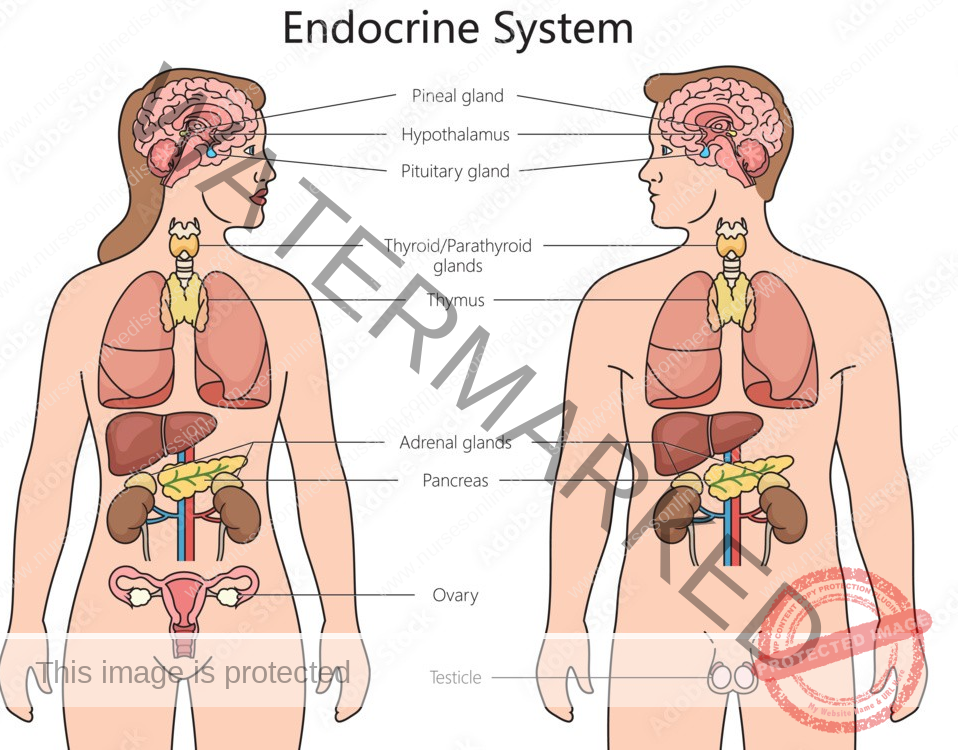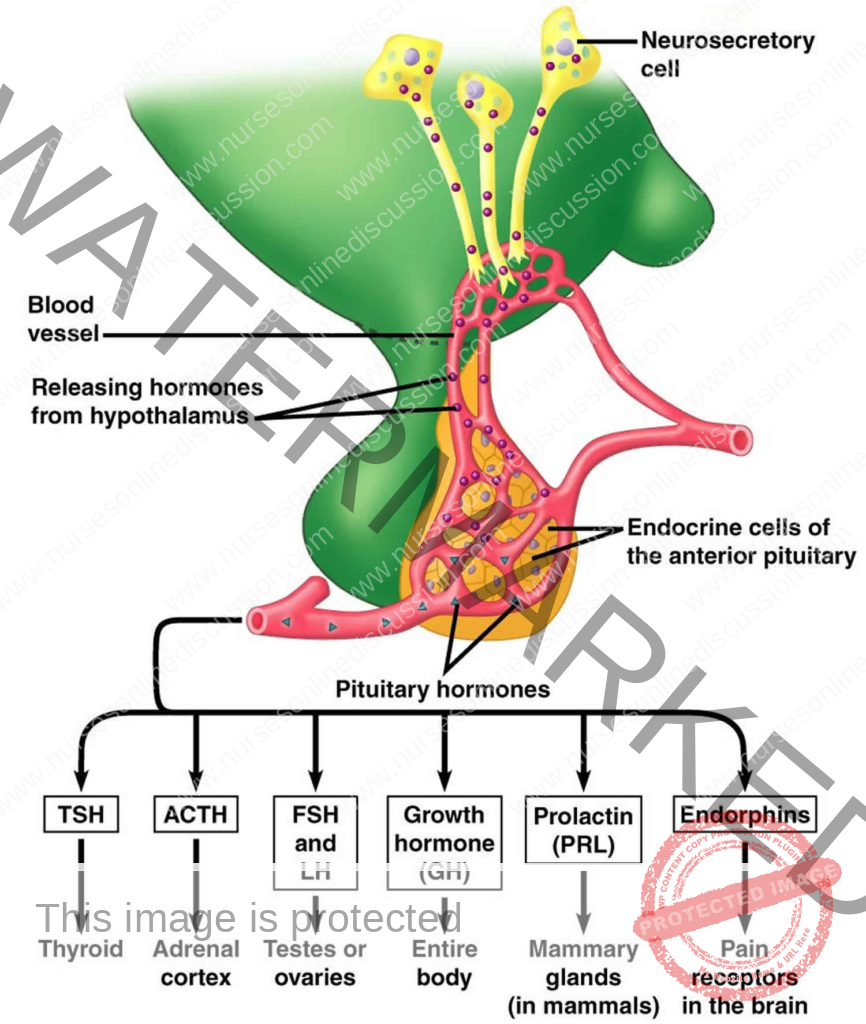Conditions Affecting the Edocrine System
Subtopic:
Endocrine system
Table of Contents

Learning Objectives
Describe the structure and function of major endocrine glands, including the pituitary, thyroid, adrenal, and reproductive glands.
Explain hormone mechanisms, focusing on receptor binding, second messengers like cAMP, and intracellular signaling.
Understand feedback regulation, distinguishing between negative and positive feedback in hormone control.
Identify hormone classifications and their chemical nature, such as protein-based versus other types.
Discuss the role of the hypothalamus, especially its regulatory influence over the anterior pituitary.
Recognize clinical implications of hormone imbalances, including conditions like gigantism, acromegaly, and hypoglycemia.
REVIEW OF ANATOMY AND PHYSIOLOGY OF ENDOCRINE SYSTEM
The endocrine system is a network of ductless glands. These glands produce hormones, which are released directly into the bloodstream. The blood then transports these hormones to specific target cells located throughout the body.
Components
The endocrine system includes these primary components:
Pituitary gland
Parathyroid gland
Thyroid gland
Adrenal gland
Pancreas
Testes and ovaries
Hormones
as chemical messengers, exert their effects on distant target tissues. Hormones can be categorized based on their chemical structure, with some being protein-based and others having different compositions.
Hormone action often involves binding to specific receptors on the cell membrane. This interaction frequently triggers the adenylyl cyclase system within the cell. Adenylyl cyclase is an enzyme attached to the cell membrane. It converts Adenosine triphosphate (ATP), the cell’s main energy currency, into Cyclic adenosine monophosphate (cAMP). cAMP acts as a second messenger, initiating a cascade of intracellular signals that can ultimately lead to protein synthesis and other cellular responses.
Hormone production is typically regulated by a negative feedback mechanism. This means that as hormone levels in the blood increase, this increase signals the gland to reduce further hormone production, maintaining a stable internal environment.
Pituitary gland
The pituitary gland, often called the “master gland,” is divided into two main lobes: the anterior and posterior lobes. The anterior lobe secretes a variety of hormones, including:
Adrenocorticotrophic hormone (ACTH): Stimulates the adrenal glands.
Somatotrophic hormone (STH)/(GH): Also known as growth hormone, essential for growth.
Thyroid stimulating hormone (TSH): Controls the thyroid gland’s activity.
Follicle stimulating hormone (FSH): Plays a crucial role in reproductive functions.
Luteinizing hormone (LH): Also vital for reproduction.
Melanocyte stimulating hormone (MSH): Affects skin pigmentation.
The posterior lobe of the pituitary gland releases:
Anti diuretic hormone (ADH): Also known as vasopressin, regulates water balance.
Vasopressin: Another name for ADH, highlighting its role in blood pressure.
Oxytocin: Involved in social bonding, reproduction, and childbirth.
The hypothalamus, a region of the brain, exerts control over the anterior pituitary’s secretions by releasing regulatory hormones. These hypothalamic hormones either stimulate or inhibit the release of anterior pituitary hormones.
Growth hormone (GH) promotes the growth of muscles and bones. It achieves this either by influencing the liver to produce somatomedins (also known as insulin-like growth factors) or by directly enhancing the incorporation of amino acids into proteins.
Hypoglycemia, a condition of low blood sugar, is a strong trigger for growth hormone release. Conversely, obesity tends to dampen the release of growth hormone.
Excessive growth hormone secretion can lead to distinct conditions depending on when it occurs. If it happens before the epiphyseal plates (growth plates) in bones have fused, it results in gigantism, characterized by excessive height. If excess secretion occurs after epiphyseal fusion, it causes acromegaly, leading to the enlargement of hands, feet, and facial features.

The endocrine system overview
The endocrine system is characterized by glands that are physically separate from one another and lack direct physical connections. These endocrine glands consist of clusters of specialized cells responsible for hormone production. These cell groups are richly supplied with capillaries, which facilitate the diffusion of hormones – the system’s chemical messengers – directly from the producing cells into the bloodstream. Because they release hormones directly into the blood, these glands are commonly known as ductless glands. The bloodstream then carries these hormones throughout the body to specific target tissues and organs, potentially located far from the originating gland, where they exert influence on processes like cellular growth and metabolism.
Maintaining homeostasis, the stable internal environment of the body, is a function shared by the autonomic nervous system and the endocrine system. The autonomic nervous system handles rapid adjustments, whereas the endocrine system is primarily involved in slower, more precise regulatory actions.
While technically part of the brain, the hypothalamus plays a crucial regulatory role in the endocrine system by controlling the pituitary gland, thus indirectly affecting the function of many other endocrine glands.
The ovaries in females and the testes in males begin to secrete hormones related to the reproductive system following puberty. Additionally, the placenta, which develops during pregnancy to support the growing fetus, also performs an endocrine function. Furthermore, some hormones act locally, influencing nearby cells without needing to travel to distant target organs.
Overview of Hormones
When a hormone reaches its intended target cell, it binds to a specific receptor. This binding acts like a switch, initiating or modifying chemical or metabolic reactions within the cell.
The concentration of a hormone in the blood is dynamic and subject to self-regulation within a normal range. Hormone release is typically triggered by a specific stimulus, and the hormone’s action often works to reverse or counteract that initial stimulus through a negative feedback mechanism. This regulatory process can be indirect, involving the release of hormones by the hypothalamus and the anterior pituitary gland (as seen with steroid and thyroid hormones), or it can be direct, responding to blood levels of the stimulus itself (like insulin and glucagon).
In contrast to negative feedback, a positive feedback mechanism amplifies the initial stimulus, leading to an increased release of the hormone until a specific process is completed, at which point the stimulus ceases. A key example of this is the release of oxytocin during labor.
Join Our WhatsApp Groups!
Are you a nursing or midwifery student looking for a space to connect, ask questions, share notes, and learn from peers?
Join our WhatsApp discussion groups today!
Join NowRelated Topics
Medical Conditions Affecting the Endocrine System
- Applied Anatomy and Physiology of the Endocrine System
- Acromegaly/Gigantism (Hyperpituitarism)
- Dwarfism (Panhypopituitarism)
- Addison’s Disease (Adrenal Insufficiency)
- Pheochromocytoma
- Cushing’s Syndrome
- Hyperaldosteronism
- Thyrotoxicosis
- Diabetes Mellitus
Conditions Affecting the Nervous System
- Applied Anatomy and Physiology of the Nervous System
- Trigeminal Neuralgia
- Bell’s Palsy
- Parkinson’s Disease
- Spinal Cord Compression
- Transverse Myelitis
Medical Diseases Affecting the Renal System
- Anatomy and Physiology of the Renal System
- Renal Disorders
- Urinary Tract Infections (UTIs)
- Cystitis
- Renal Failure (Acute and Chronic)Nephrotic Syndrome
- Polycystic Kidney Disease (PKD)
- Kidney Stones (Nephrolithiasis)
Conditions of the Lymphatic System
- Anatomy and Physiology of the Lymphatic System
- Lymphedema
- Lymphangitis and Lymphadenitis
- Hodgkin’s Disease
Conditions of the Musculo-Skeletal System
- Anatomy and Physiology of the Musculo-Skeletal System
- Tendonitis
- Rheumatoid Arthritis
- Osteoarthritis
- Gout
- Bursitis
- Ankylosing Spondylitis
- Osteoporosis
- Paget’s Disease
Skin Conditions (Dermatology)
Get in Touch
(+256) 790 036 252
(+256) 748 324 644
Info@nursesonlinediscussion.com
Kampala ,Uganda
© 2025 Nurses online discussion. All Rights Reserved Design & Developed by Opensigma.co

